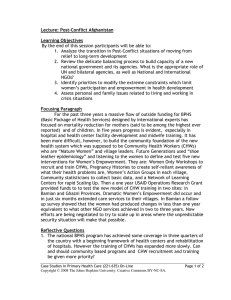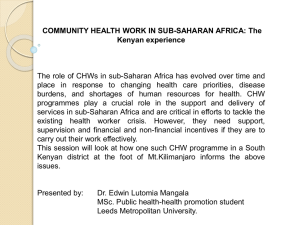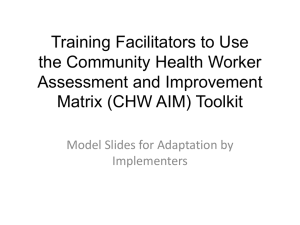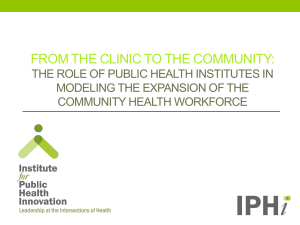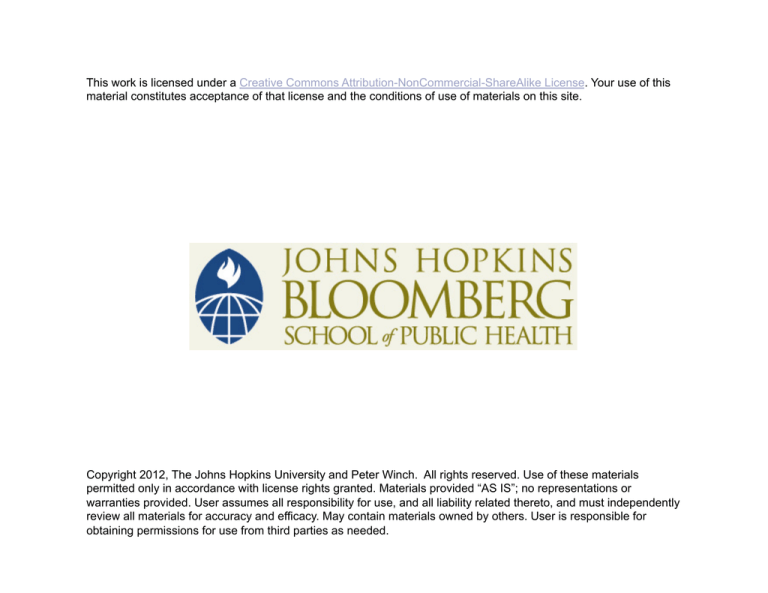
This work is licensed under a Creative Commons Attribution-NonCommercial-ShareAlike License. Your use of this
material constitutes acceptance of that license and the conditions of use of materials on this site.
Copyright 2012, The Johns Hopkins University and Peter Winch. All rights reserved. Use of these materials
permitted only in accordance with license rights granted. Materials provided “AS IS”; no representations or
warranties provided. User assumes all responsibility for use, and all liability related thereto, and must independently
review all materials for accuracy and efficacy. May contain materials owned by others. User is responsible for
obtaining permissions for use from third parties as needed.
Behavior of health workers
Peter Winch
Health Behavior Change at the Individual,
Household and Community Levels
224.689
Rest of this course
Today
– Lecture
– Discussion groups
Thursday
– 1 hour lecture/discussion: “Career paths
related to community and behavioral
interventions”
Wed Dec 21: Final assignment due,
complete course evaluations
Health workers
Broadly defined:
– Licensed and unlicensed
– Public and private sectors
– Health facilities or communities
Common concerns
about health workers
Poor performance
Attrition
Migration to other countries
Health worker performance
“Adherence to accepted standards or
guidelines”
Demonstrated to be poor in multiple
studies
Consequences:
– Decreased careseeking from health
workers, low use of health facilities and
health services
– Harm from inappropriate injection
practices, non-sterile surgical
procedures etc.
Health worker performance
References:
– Winch PJ, Bhattacharyya K, Debay M, Sarriot
EG, Bertoli SA, Morrow RH. “Improving the
Performance of Facility and Community-based
Health Workers”. Child Survival Technical
Support Project, Calverton MD, December
2003
– Rowe AK, de Savigny D, Lanata CF, Victora
CG. How can we achieve and maintain highquality performance of health workers in lowresource settings? Lancet 2005; 366(9490):1
026-35
Factors Influencing
Performance
Job expectations
Performance feedback
Environment and tools
Motivation
Organizational support
Skills & knowledge
Health worker performance
Frequent focus of programmatic initiatives
However: Performance and quality of care
are at the end of a cascade of choices that
health care workers make
Need to address ‘upstream’ choices as well
as health worker performance
Cascade of choices for health workers
Undergo professional training Y/N
Type of training/profession/specialization
Practice in the country vs. migrate to another
country
Public sector vs. private sector employment
Site/clinic/health facility to practice
Live at site of practice vs. commute to site
Performance/Quality of care/Style of practice
– Assessment/diagnosis
– Treatments/procedures
– Communication/counseling
– Outreach/Engagement with community
Paradigms for thinking about
health worker performance
Administrative/supervisory
Behavior change
Quality assurance/performance
improvement
Political economy
Administrative/supervisory
paradigm
Health workers are part of an organization
The organization should define:
– Roles and responsibilities
– Guidelines for carrying out the work
Supervision, based on the guidelines, is key to
maintaining performance
Considerable evidence that supervision can have
an effect, but full implementation limited by
operational constraints
HUGE interest currently in mobile technologies as
tools to overcome these constraints
Constraints to supervision
Supervisor
Insufficient numbers of
supervisors
No training in supervision
Inappropriate styles of
supervision e.g. punitive
No funds for transport to
or accommodation at
peripheral sites
Identifying problems
creates difficulties for
supervisor
Health worker
Irregular salary payments
“Why should I listen to
you?”
Increased mobility +
Mixed public-private styles
of practice
Cell phones: Can
anticipate and prepare for
supervisory visits,
coordinate work in public
and private practice
Behavior change paradigm
‘Performance’ of health workers is the
same as their behavior
Identify discrete behaviors we want health
workers to be practicing
Using behavior change models (TRA, SCT,
Transtheoretical etc.) and intervention
modalities (social marketing), implement
behavior change interventions targeted at
health workers
Behavior change paradigm
Strengths
Body of literature to
support behavior
change approaches
Voluntary behavior
change perspective
Focus on motivations
of health workers
rather than their
knowledge
Weaknesses
Often difficult to
reduce performance
to discrete behaviors
May be unacceptable
to organization
Many organizations
lack necessary skills
Focus on individual
level often
inappropriate
Performance Improvement/
Quality Assurance Paradigm
Performance Improvement/
Quality Assurance Paradigm
Sources of information:
– www.hciproject.org/improvement_tools
– http://en.wikipedia.org/wiki/
Quality_assurance
Performance Improvement/
Quality Assurance Paradigm
Typically has people work as teams to
analyze the problem (the gap) and identify
solutions
Advantages of teams
– Focus on overall quality, rather than
individual performance, may be less
threatening and more acceptable
– Teams may come up with innovative
solutions
– Peer support and pressure to make
changes, establish new norms
Performance Improvement
Questions teams are to address:
– What performance do we want?
– What performance have we got now?
– What are the causes of the performance
gap? (Gap between what we want and
what we actually have)
– Which solution gives us the greatest
return on our investment?
The Performance Improvement
Process
Reference:
– http://www.reproline.jhu.edu/english/
6read/6pi/pi_what.htm
GET and MAINTAIN STAKEHOLDER AGREEMENT
CONSIDER
INSTITUTIONAL
CONTEXT
DEFINE
DESIRED
PERFORMANCE
FIND ROOT
CAUSES
Why does the
performance
gap exist?
MISSION
GOALS
STRATEGIES
CULTURE
CLIENT and
COMMUNITY
PERSPECTIVES
SELECT
IMPLEMENT
INTERVENTIONS
What can be done INTERVENTIONS
to close the
performance gap?
DESCRIBE
ACTUAL
PERFORMANCE
MONITOR AND EVALUATE PERFORMANCE
Use the Performance Improvement Process
to Guide Program Development
Work with stakeholders to:
Define desired performance
Conduct a performance gap analysis
Conduct a root cause analysis
Identify the most cost-effective
interventions to close the performance gap
Implement interventions as appropriate
Evaluate the impact of interventions on
performance
Limitations of the Performance
Improvement Paradigm
In practice, tends to focus on the health
care facility as the unit of analysis
(although the model includes the
institutional context)
Less room for consideration of life
situation, needs and motivation of
individual health workers
Paradigms for thinking about
health worker performance
√ Administrative/supervisory paradigm
√ Behavior change paradigm
√ Quality assurance/performance
improvement
Political economy perspective
– Found in a range of social science
critiques of development e.g.
anthropology, development studies etc.
Political economy perspective
Does it make sense to focus on the
performance of individual health workers?
– They have little control over the
situation
– Poor working conditions
– Low salaries
Isn’t this blaming the victim?
Political economy perspective
‘Real’ underlying causes of poor health worker
performance include:
– Chronic underfunding of the health system
and health workers in many countries, low
salaries for health workers
– Focus on commodities, not people
– Influence of drug companies and other
commercial interests on health policy and
health care spending decisions
– Gender roles and constraints imposed on
female health workers
Political economy perspective
Health workers as distribution channels for
commodities
– Concern about health worker
performance often arises when it is
found that commodities are not
distributed or used correctly
– Problems with commodities provoke
more concerns that poor counseling and
communication, deficient or lacking
surgical care, little community outreach
Political economy perspective
Solutions should include:
– Adequate funding of the health system,
increased salaries
– Balanced attention to commodities and
human resources
– Capacity building and training
– Limit influence of commercial interests
– Address gender-related constraints
Final issue:
Attrition/retention
of voluntary workers
Attrition/retention of voluntary workers
For salaried health workers, attention tends to be
on performance and motivation
For voluntary workers e.g. community health
workers (CHWs), much attention currently on
attrition/retention
Voluntary workers have expanding range of
tasks, e.g.
– Mass treatment for trachoma, onchocerciasis,
malaria (IPT, IPTI)
– Voluntary counseling and testing
– Ensuring compliance with AIDS and TB
treatment
– Management of sick newborns
Program cost-effectiveness threatened by high
attrition, need to recruit & train replacements
Multilevel perspective on attrition/
retention
Factors affecting attrition/retention act at
different levels
– Individual education, motivation etc.
– Family
– Community
– District or Program
– National
Bhattacharyya K,
Winch P, LeBan K,
Tien M.
Community health
workers incentives
and disincentives:
How they affect
motivation,
retention and
sustainability.
BASICS II Project,
Arlington VA,
October 2001.
Multilevel perspective on CHW
Incentives and Disincentives
Individual
– Monetary factors
– Non-monetary factors
Community
– Factors that Motivate the Individual CHW
– Factors that Motivate Communities to Support
and Sustain CHWs
District/Health facility
– Factors that Motivate MOH Staff to Support
and Sustain CHWs
Individual level: Monetary Factors
that Motivate voluntary workers
Incentives
Satisfactory
remuneration /
Material Incentives /
Financial Incentives
Possibility of Future
Paid Employment
Disincentives
Inconsistent
Remuneration
Change in Tangible
Incentives
Inequitable
Distribution of
Incentives Among
Different Types of
Community Workers
Individual level: Non-Monetary Factors
that motivate voluntary workers
Incentives
Community Recognition and
Respect of CHW work
Acquisition of Valued Skills
Personal Growth and
Development
Accomplishment
Peer Support
CHW Associations
Identification (badge, shirt)
and Job Aids
Status within Community
Preferential Treatment
Flexible and Minimal Hours
Clear Role
Disincentives
Person Not from
Community
Inadequate Refresher
Training
Inadequate
Supervision
Excessive Demands /
Time Constraints
Lack of Respect from
Health Facility Staff
Community Level Factors that
Motivate the Individual CHW
Incentives
Community Involvement
in CHW Selection
Community Organizations
that Support CHW Work
Community Involvement
in CHW training
Community Information
Systems
Disincentives
Inappropriate Selection of
CHW
Lack of community
involvement in CHW
selection, training, and
support
Factors that Motivate Communities
to Support and Sustain CHWs
Incentives
Witnessing Visible
Changes
Contribution to
Community
Empowerment
CHW Associations
Successful Referrals to
Health Facilities
Disincentives
Unclear Role and
Expectations
(preventive versus
curative care)
Inappropriate CHW
behavior
Needs of the
Community Not Taken
into Account
Factors that Motivate MOH Staff to
Support and Sustain CHWs
Incentives
Policies / Legislation
that Support CHWs
Witnessing Visible
Changes
Funding for
Supervisory Activities
from Government
and / or Community
Disincentives
Inadequate Staff and
Supplies
Interaction of different dimensions
Performance
Environment
Motivation
Retention/Attrition
Relationship with
community

